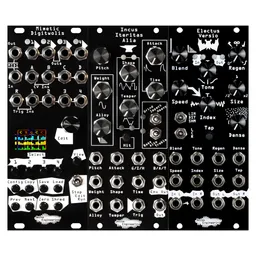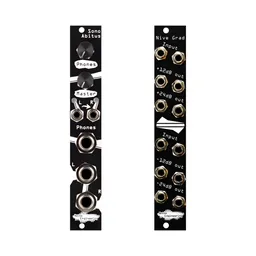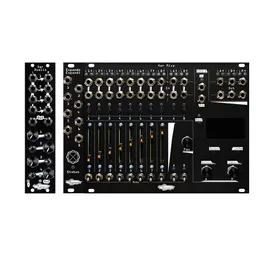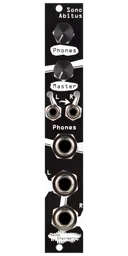If you have a Eurorack system, there’s a good chance you have some other gear in your studio. Being able to use all of your instruments and equipment together can open up some fun options and flexibility, so today we’ll be exploring the utility modules that can help make this possible.
You might not need any utilities for this
For a long time, I didn’t use any sort of input/output utilities with my system. I didn’t have any external instruments I wanted to use with it, and I recorded directly to an audio interface. If the output got too hot in a particular patch, I’d run the entire patch through a pair of attenuators and turn them down until the output didn’t clip. This worked well for a few years.
Eventually, I wanted to integrate some external gear, and after a studio rearrange I had to do some longer cable runs from my synth to my recording setup. I added a preamp module for bringing up the levels of some quiet gear to match the modular, and a balanced output module so that I wouldn’t run into noise issues on long cable runs.
You may not need any modules for inputs or outputs at all, depending on your equipment and goals. However, they can make things easier, and are necessary for some specific situations like balanced connections or headphone outputs.
Speaking of…
Headphones
While headphones often use 1/8" connections, they can’t be directly connected to the audio output of a normal module. Headphones often require dedicated amplifiers to function properly, and their stereo connections mean that Eurorack jacks won’t make the proper connection.
Enter headphone output modules. A headphone output will have either a 1/4" or 1/8" connection for your headphones, inputs for your modular signal, and a level control so that you can adjust the volume of the output, too.
Headphone outputs aren’t the most exciting utility, but they’re one you’ll use in every patch if you want to jam with privacy (or without waking up the neighborhood).
Gainstaging and balancing
Output modules aren’t just for headphones. For example, our Sono Abitus features a stereo headphone jack, as well as a stereo pair of 1/4" balanced TRS connections, with level controls for both output types.
The balanced outputs are helpful for avoiding noise on long cable runs, and the level control is a great way to gainstage. For example, if you’re using an external compressor as an end-of-chain processor on your whole rack, an output module with a level control allows you to dial in and hit the compressor at just the right output level.

Processing external signals with Eurorack
If you have any non-Eurorack gear in your studio – drum machines, fixed-architecture synthesizers, samplers – they may output at different levels than your Eurorack system. Eurorack outputs tend to be quite hot, often exceeding 10V peak-to-peak. Some synths are much quieter – I’ve seen some as low as 1V peak-to-peak – and things like guitars and basses generally require external amplification, too.
External input modules offer amplification to help match the level of a quiet external signal to the expected level of Eurorack processors. The top section of Nive Grad, for instance, offers +12 dB and +24dB outputs: the +12 dB output is generally enough for synths and drum machines, and the +24 is enough for guitars and pedals. If you’ve always wanted to run your bass through your Eurorack system, an external input module will open up a lot of new options.Processing Eurorack with external signals
A final spot where external interfacing utilities come in handy is with guitar pedals. There are possibly more guitar pedals than Eurorack modules, which is saying something, so if you want to experiment with even more processing possibilities, pedals are a wonderful avenue to explore.
However, pedals generally expect much quieter guitar-level signals at their inputs, and will output at lower levels, too. This means that we’ll need to drop the level of our Eurorack signal down before patching into a pedal, and bring the pedal output back up to Eurorack levels.
Something like Nive Grad makes this simple, since it has level reducing and level increasing sections, and enough ins and outs to work in stereo, too. Ever wondered what an oscillator sounds like through your pedal board? Now you can find out!
Bottom line: It’s easy to integrate your Eurorack into your larger setup
If you have synths, samplers, drum machines, or other gear and want to be able to integrate your modular setup with them, it’s simple with the addition of just a couple of simple, widely available utilities.








